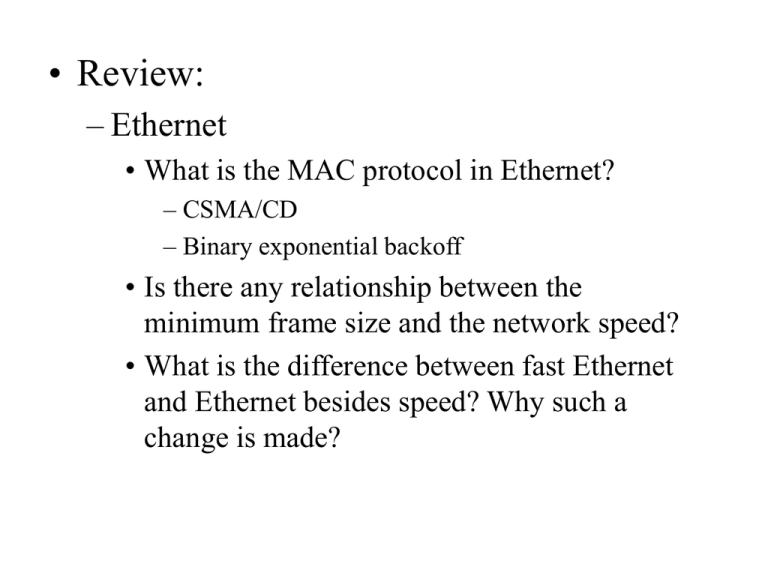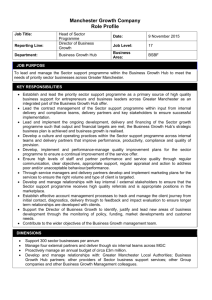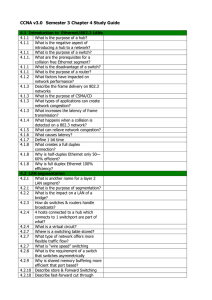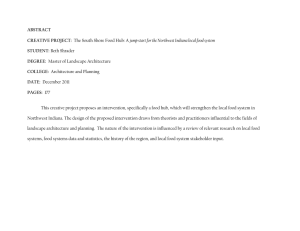• Review: – Ethernet
advertisement

• Review:
– Ethernet
• What is the MAC protocol in Ethernet?
– CSMA/CD
– Binary exponential backoff
• Is there any relationship between the
minimum frame size and the network speed?
• What is the difference between fast Ethernet
and Ethernet besides speed? Why such a
change is made?
• Interconnecting LANs
– Why?
• When too many machines are in a single LAN, the
bandwidth may not be sufficient to support all the
machines -- need to partition one LAN into multiple
LANs to get higher aggregate throughput.
• When the area is too big for a single LAN (e.g. 5km
for Ethernet)? We can create multiple collision
domains and interconnect the LANs.
• For security reasons. Ethernet cards support a
promiscuous mode which allows a station to get all
frames received.
• Internetworking at different levels
• repeaters: physical layer, copy signals from one
network to another network.
• bridges: data link layer, (selectively) copy frames
from one network to another network.
• routers or gateways: network layer, routing and
forwarding.
• application gateway or converter: application layer.
translate between OSI mail and SMTP mail
• Brouter: bridge + router
Interconnecting with hubs
• Backbone hub interconnects LAN segments
• Extends max distance between nodes
• But individual segment collision domains become one
large collision domain
• Can’t interconnect 10BaseT & 100BaseT
hub
hub
hub
hub
Switch
• Link layer device
– stores and forwards Ethernet frames
– examines frame header and selectively forwards frame
based on MAC dest address
– when frame is to be forwarded on segment, uses
CSMA/CD to access segment
• transparent
– hosts are unaware of presence of switches
• plug-and-play, self-learning
– switches do not need to be configured
Forwarding
switch
1
2
hub
3
hub
hub
• How do determine onto which LAN segment to
forward frame?
• Looks like a routing problem...
Self learning
• A switch has a switch table
• entry in switch table:
– (MAC Address, Interface, Time Stamp)
– stale entries in table dropped (TTL can be 60 min)
• switch learns which hosts can be reached through
which interfaces
– when frame received, switch “learns” location of
sender: incoming LAN segment
– records sender/location pair in switch table
Filtering/Forwarding
When switch receives a frame:
index switch table using MAC dest address
if entry found for destination
then{
if dest on segment from which frame arrived
then drop the frame
else forward the frame on interface indicated
}
forward on all but the interface
else flood
on which the frame arrived
Switch example
Suppose C sends frame to D
1
B
C
A
B
E
G
3
2
hub
hub
hub
A
address interface
switch
1
1
2
3
I
D
E
F
G
H
• Switch receives frame from from C
– notes in bridge table that C is on interface 1
– because D is not in table, switch forwards frame into
interfaces 2 and 3
• frame received by D
Switch example
Suppose D replies back with frame to C.
address interface
switch
B
C
hub
hub
hub
A
I
D
E
F
G
A
B
E
G
C
1
1
2
3
1
H
• Switch receives frame from from D
– notes in bridge table that D is on interface 2
– because C is in table, switch forwards frame only to
interface 1
• frame received by C
• What happens when the switches form
loops?
• Solution: don’t allow loops to occur in the
forwarding path by constructing a spanning tree.
– A spanning tree of a graph G is a subgraph of G such that
all nodes are connected without a loop.
– How to build a spanning tree of a graph G?
One way to do it is to fix a root and compute the
shortest paths from the root to all other nodes.
Switch: traffic isolation
• switch installation breaks subnet into LAN segments
• switch filters packets:
– same-LAN-segment frames not usually forwarded onto
other LAN segments
– segments become separate collision domains
switch
collision
domain
hub
collision domain
hub
collision domain
hub
Switches: dedicated access
• Switch with many
interfaces
• Hosts have direct
connection to switch
• No collisions; full duplex
A
C’
B
switch
C
Switching: A-to-A’ and B-toB’ simultaneously, no
collisions
B’
A’
Institutional network
to external
network
mail server
web server
router
switch
IP subnet
hub
hub
hub
Switches vs. Routers
• both store-and-forward devices
– routers: network layer devices (examine network layer headers)
– switches are link layer devices
• routers maintain routing tables, implement routing algorithms
• switches maintain switch tables, implement filtering, learning
algorithms, cannot use redundant path.





